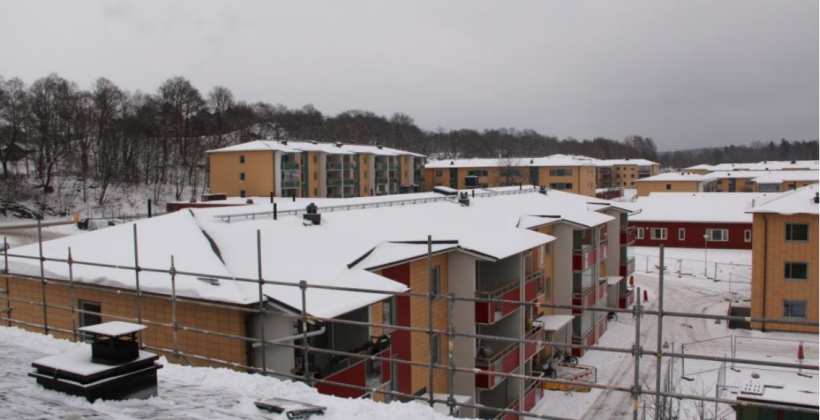
Location
Description
The Swedish demo site of the BEEM-UP project is located in Alingsås and known as Brogarden. The area consists of multi-dwelling buildings built in the period 1971 to 1973, comprising a total of 300 apartments, divided into 16 houses with 2 to 4 floors each. All apartments have a balcony or patio.
Overall, a gross floor area of 14 860 m² has been refurbished in the project. The houses were stripped down to the frame and rebuilt using passive house techniques. While doing this, the layout of the apartments has been changed slightly to ensure better accessibility and to provide an increased number of large apartments that suit the modern way of living better than the old layout.
Brogarden is classified by the municipality as an area of conservation value. The building materials have therefore been chosen to resemble those of the original building.
Demo Site Expected Impact
*Please note that there is no design data for the electrical consumption of the demo site.
The energy consumption figures amounted to 210 kWh/m²/yr before the project and 90 kWh/m²/yr after the interventions were implemented. The total thermal consumption was reduced by two thirds, from 170 kWh/m²/yr to 58 kWh/m²/yr thanks to the passive strategies deployed in the building, such as the highly efficient insulation. These results show that the interventions led to a reduction in the thermal energy consumption of over 100 kWh/m²/yr.
The results from the Swedish demo site show that the anticipated savings regarding space heating are largely achieved, while the expectation on the reduction of domestic hot water consumption is not met. The 45 % savings in energy for domestic hot water seemed to be too ambitious, especially as the consumptions are very much dependent on the tenants’ behaviour. The discrepancies could be explained by the fact that the calculations were made with the assumption that the heating and ventilation systems would be functioning perfectly.
The electricity consumption (sum of domestic and common consumptions) that includes lighting consumption showed a decrease of 33.7 %. The discrepancy between this result and the objective of the project on lighting (42 %) could be explained by the tenants’ habits.
The BEEM-UP project did not set any goals regarding the reduction of CO2 emissions, but reached a reduction of 61 tonnes of CO2. Regarding the overall primary energy saving, the objective was saving 75 % on heating consumption and 45 % on domestic hot water. The monitored results show that the primary energy savings have been reduced by 75 % and 12 % respectively.
Technologies
Buildings and energy
Energy efficiency in buildings
- Retrofitting the building envelope
- New wall containing several layers of insulation and slotted steel studs with a total of 440 mm insulation
- 100 mm expanded polystyrene extending 1 metre below ground level was added to the basement, along with 100 mm drainage panel downwards to the ground floor
- 400 mm new mineral wool insulation was fitted in the roof space
- The windows were replaced with triple pane windows with insulated glass.
- Building integrated renewable energy sources
- Photovoltaic panels on the roof and/or walls were installed on three of the buildings
- Building services (HVAC and lighting)
- Optimised lighting: low-energy fittings in the apartments and low-energy or halogen lighting and LED lighting in stairwells
- Mechanical ventilation system with heat recovery: balanced ventilation with heat recovery, where single unit serves entire building
ICT
- Building energy management system
- ICT energy management was installed including smart meters. Electricity is measured individually, hot water is monitored remotely for each apartment, and heating is measured for each staircase.
The investment cost for the intervention was EUR 1 500 per m², which represents a total of EUR 22.25 million. According to the data provided and SCIS calculations, the annual cost savings for energy come to EUR 361 633, from a total cost of EUR 394 613. Therefore the annual costs after renovation equal EUR 32 980.
With regard to the payback period, an inflation rate of 3 % for the energy prices has been assumed while the discount rate has been assumed to be 3 %. The resulting payback period is 30 years.
The financial analysis shows that the profitability of the project is not given due to the high investments in comparison to the low energy cost savings. This however does not reflect non-monetary benefits that might occur through implementation.
Thematic Field
- Refurbished Building(s)
